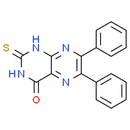Description
SCR7 pyrazine is a DNA ligase IV inhibitor that blocks nonhomologous end-joining (NHEJ) in a ligase IV-dependent manner. SCR7 pyrazine is also a CRISPR/Cas9 enhancer which increases the efficiency of Cas9-mediated homology-directed repair (HDR). SCR7 pyrazine induces cell apoptosis and has anticancer activity.
Product information
CAS Number: 14892-97-8
Molecular Weight: 332.38
Formula: C18H12N4OS
Chemical Name: 6, 7-diphenyl-2-sulfanylidene-1, 2, 3, 4-tetrahydropteridin-4-one
Smiles: O=C1NC(=S)NC2=NC(=C(N=C21)C1C=CC=CC=1)C1C=CC=CC=1
InChiKey: GSRTWXVBHGOUBU-UHFFFAOYSA-N
InChi: InChI=1S/C18H12N4OS/c23-17-15-16(21-18(24)22-17)20-14(12-9-5-2-6-10-12)13(19-15)11-7-3-1-4-8-11/h1-10H,(H2,20,21,22,23,24)
Technical Data
Appearance: Solid Power
Purity: ≥98% (or refer to the Certificate of Analysis)
Solubility: DMSO : 100 mg/mL (300.86 mM; Need ultrasonic)
Shipping Condition: Shipped under ambient temperature as non-hazardous chemical or refer to Certificate of Analysis
Storage Condition: Dry, dark and -20 oC for 1 year or refer to the Certificate of Analysis.
Shelf Life: ≥360 days if stored properly.
Stock Solution Storage: 0 - 4 oC for 1 month or refer to the Certificate of Analysis.
Drug Formulation: To be determined
HS Tariff Code: 382200
How to use
In Vitro:
SCR7 pyrazine (20-100 μM; 24 hours; MCF7 cells) treatment interferes with NHEJ in cells, leading to accumulation of unrepaired double-strand breaks (DSBs). SCR7 pyrazine treatment shows a dose-dependent decrease in cell proliferation with IC50 values of 40 μM, 34 μM, 44 μM, 8.5 μM, 120 μM, 10 μM and 50 μM for MCF7, A549, HeLa, T47D, A2780, HT1080 and Nalm6 cells, respectively. In MCF7 cells, SCR7 pyrazine (20, 40 μM) treatment increases phosphorylation of ATM and activates p53, decreases MDM2, BCL2, resulting in activation of proapoptotic proteins, PUMA and BAX. And the shorter fragments of MCL1, PARP1, Caspase 3, and Caspase 9 cleavage are upregulated in a dose-dependent manner.
In Vivo:
SCR7 pyrazine (10 mg/kg; intraperitoneal injection; six doses; BALB/c mice) treatment significantly reduces breast adenocarcinoma-induced tumor and increases lifespan.
References:
- Srivastava M, et al. An inhibitor of nonhomologous end-joining abrogates double-strand break repair and impedes cancer progression. Cell. 2012 Dec 21;151(7):1474-87.
- Lin C, et al. Increasing the Efficiency of CRISPR/Cas9-mediated Precise Genome Editing of HSV-1 Virus in Human Cells. Sci Rep. 2016 Oct 7;6:34531.
Products are for research use only. Not for human use.
Payment & Security
Your payment information is processed securely. We do not store credit card details nor have access to your credit card information.


